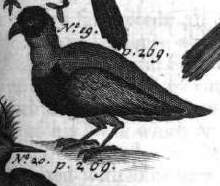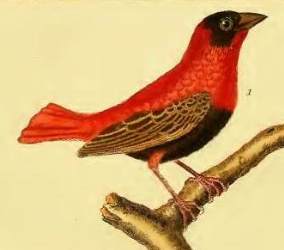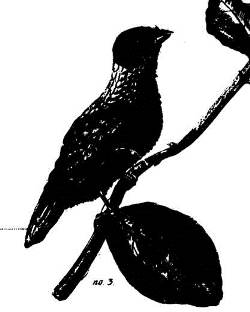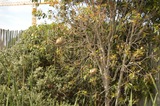Weaver species
Choose different species from drop-down list and press 'Go' button. See Full species list.Northern Red Bishop Euplectes franciscanus
IUCN: Least concern Discovery: 015Categories: red bishops, pest, blue eggs,
News items about species
Discovery

figure from Bosman 1704 
figure from Daubenton 1783 
figure from Isert 1789 
type locality circled IntroductionThe Northern Red Bishop was formally named by Paul Erdmann Isert, a German botanist. Isert was a Chief Surgeon in Accra, in Danish Guinea, from 1783 to 1786. He noted that these birds were present from June to August, and he collected 12 male specimens. His German publication on the birds of the area included a poor line drawing of the Northern Red Bishop - the publication appeared days before his death.Isert was not the first to write about the Northern Red Bishop. Willem Bosman gave the first description of birds from Ghana, including the Northern Red Bishop, with the first illustration (although poor) of this species, but without providing any names for most birds. The first colour illustration of the Northern Red Bishop is found in Daubenton 1783, where it is incorrectly listed as coming from the Cape. The male is clearly a Northern Red Bishop with a red chin, and not a Southern Red Bishop. Boddaert 1783 identified most birds that were illustrated in Daubenton, but in the case of plate 134 fig 1 (the Northern Red Bishop), Boddaert only refers to the Fody in Figure 2. Most likely a specimen of the Northern Red Bishop arrived in France, was illustrated in Daubenton and overlooked by Boddaert and other authors, leaving Isert to provide the first formal description for this species. Scientific citationLoxia franciscana Isert 1789 Schrift. Ges. Nat. Freund. Berlin, 19, p.332, pl.9 Accra, Ghana.Meaning of namesfranciscanus (Latin): franciscanus = Franciscus and -anus = relating to; thus refers to the scarlet robes worn by the Franciscan order (founded by St Francis of Assisi, 1182-1226).First English nameShort-tailed Crimson Weaver (Swainson 1837).Alternate namesLittle Bishop, Orange Bishop, West Nile Bishop.CollectorPaul Erdmann Isert.Date collected1783 - 1786, when Isert lived in Accra, Ghana.Locality collectedan der See auf Acra = coastal Accra.Type specimensNo type specimens known to survive. |
The above is based on Weaver Wednesday 2, a weekly series about the discovery of each weaver species.
This species text first appeared as
Weaver Wednesday [132] - Discovery [15]: Northern Red Bishop on 2014-12-24
1. Basic biology

male, figure from wikipedia Identification. The Northern Red Bishop Euplectes franciscanus is similar to the Southern Red Bishop. In the breeding male Northern Red Bishop, the black extends further back on the crown than in the Southern Red Bishop, and the tail coverts are longer, concealing the tail. The Northern Red Bishop is smaller than the Black-winged Bishop, with a small bill, brown wings and a short brown tail. The female and non-breeding male are indistinguishable from the Southern Red Bishop, and are distinguished from the Black-winged Bishop by having paler underparts, and in flight by its brown wings. The Northern Red Bishop is less streaked below than the Yellow-crowned Bishop, and the supercilium is short and white. Distribution. The Northern Red Bishop occurs across Africa from Mauritania to Somalia (see map below, based on Birds of Africa). Several subspecies of the Northern Red Bishop have been described but are no longer recognised. It is resident over most of its range, but in the far north it is a breeding rainy season migrant. Escaped birds breed near Los Angeles, California, and in the West Indies.
Habitat. The Northern Red Bishop inhabits tall open or bushed grassland. It is closely associated with giant grasses and tall crops such as millet and sorghum, but also occurs in open habitats with rank weedy vegetation. At night it roosts in thickets or tall grass. Food. The Northern Red Bishop feeds on small grass seeds and insects. Young nestlings are fed mainly with insects. Birds forage mostly on the ground by hopping. Insects are caught both on the ground and in flight. It is gregarious, and forms large flocks in the non-breeding season, associating with other seed-eaters. Flocks damage crops, and seeds of millet and sorghum are favoured. In Ethiopia flapping pieces of cloth are strung over fields to keep these birds away.
Breeding.
The Northern Red Bishop is polygynous,and a male has up to 5 females. It is territorial, with boundaries well defined, but males may be clustered in a an area. It is less colonial and more specialized in nesting requirements, than the Southern Red Bishop. The nest is a globular structure of coarse grass. The nest is built by the male, starting with a vertical ring between supporting vegetation. The nest is lined by the female with grass flowerheads, which project from the entrance. The nest is supported by grass or weed stems l-2 m above the ground; it is rarely placed in bamboo, bushes or trees, 3-6 m above the ground.
The eggs, 2-4 in a clutch, are plain blue (similar to those of the Southern Red Bishop, but slightly smaller). Only the female incubates the eggs and feeds the chicks. |
The above is based on Weaver Wednesday, a weekly series about weaver species.
This species text first appeared as
Weaver Wednesday [79]: Northern Red Bishop on 2013-12-17
2. Breeding facts
| Pair bond Polygynous, with up to five females per male Breeding season Aug-Nov in Gambia and Senegal, May-Oct in Mali and lvory Coast, Jul-Sept in Ghana, Jan-Jul in Togo, Jul-Nov in Benin, Jun-Oct in Burkina-Fasso and Nigeria, Oct in Niger, Feb-Mar and Aug-Nov in Sudan, May-Sept in Ethiopia; in Somalia, Apr and Jul in NW and Jul-Sept in S; May-Oct in NE DRCongo and May-Jun in Uganda Nest site placed 1-2m above ground and supported by vertical grassor weed stems or in cultivated crops, rarely 3-6m above ground in bamboo, bush or tree Nest building built by male, lined by female Colony size n/a Clutch size 2-4 eggs Egg colour plain blue Egg size average size of 48 eggs 17.3 x 12.8 mm (Nigeria) Incubation incubation by female only, period 13-14 days in captivity Chicks and nestling period chicks fed by female alone, nestling period 14-16 days (in captivity, more than 23 days recorded) |
Breeding information based on Handbook of the Birds of the World, Vol. 15.
3. Photos of Weaver Nests
 Vm 29065 |
Thumb-nails of most recent PHOWN records - click on one to see its full record
See all PHOWN records for this species here.
PHOWN (Photos of Weaver Nests) provides valuable info on breeding distribution and colony sizes of weavers.
You can contribute by registering and submitting photos at Virtual Museum webpage.
4. Breeding distribution
Google map showing distribution (For species with small ranges you need to zoom in at the correct area to see the range):
yellow blob - range of weaver species; read more about this here.
![]() - PHOWN records with photos
- PHOWN records with photos
![]() - PHOWN records with no photos (Nest Record Cards, other records)
- PHOWN records with no photos (Nest Record Cards, other records)
![]() - Birdpix records
- Birdpix records
![]() - comments on out of range records, or interesting records
- comments on out of range records, or interesting records
![]() - type locality
- type locality
CLICK on the marker on the map to see individual record details.
5. Range changes
Not South African speciesThe above is based on Weaver Wednesday 3, a weekly series about range changes in South African weaver species.
This species text first appeared as
n/a













